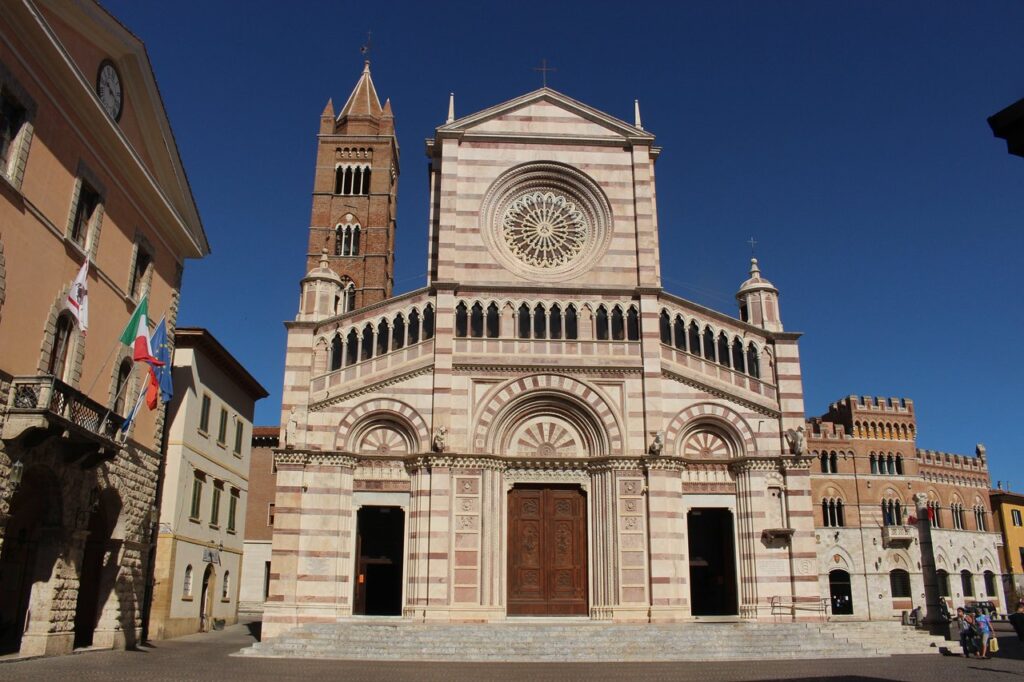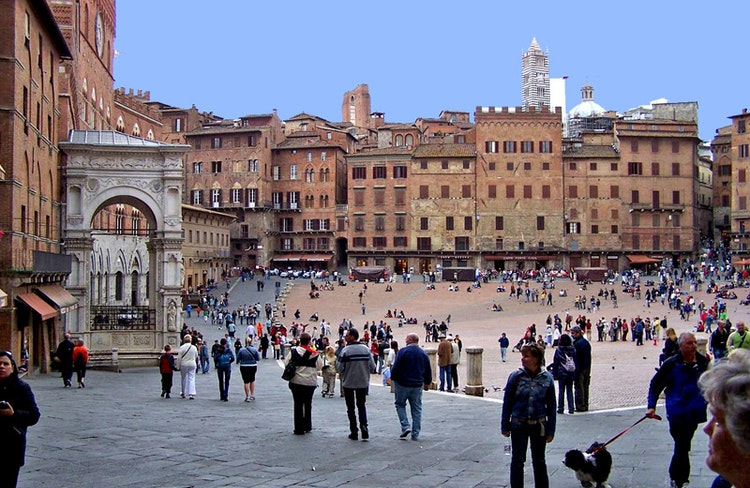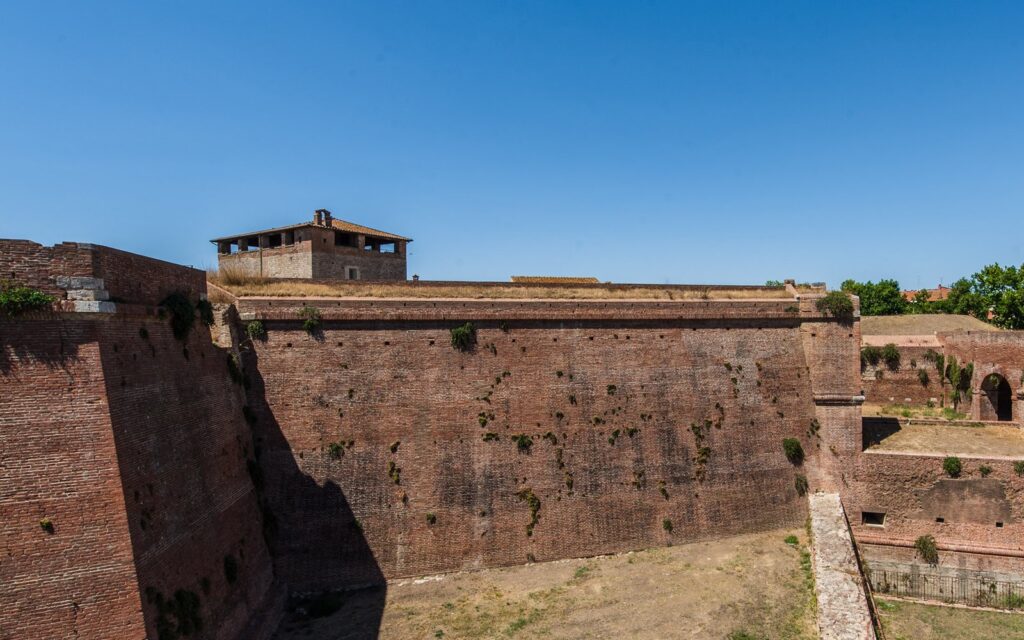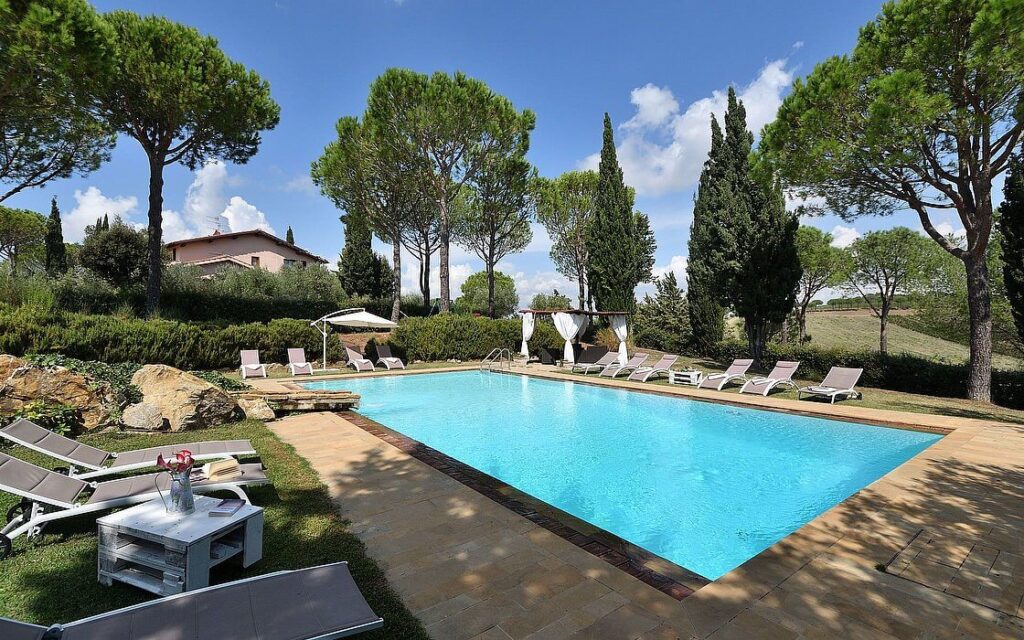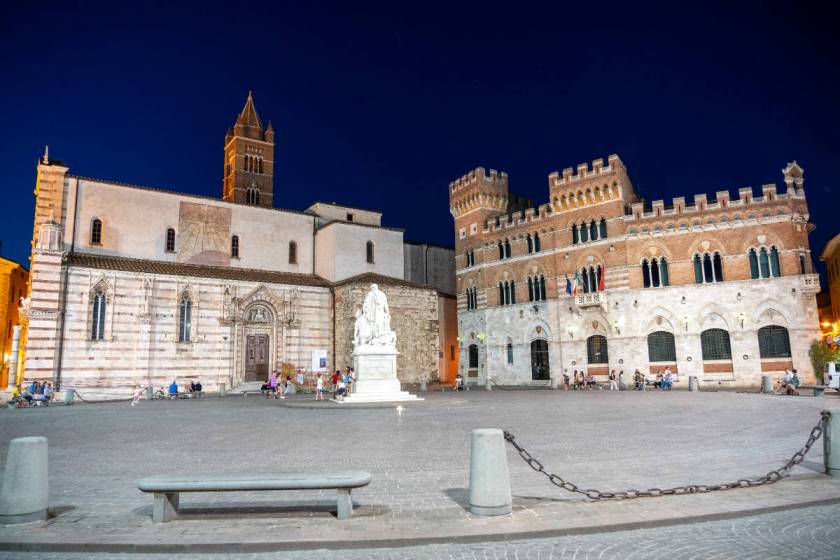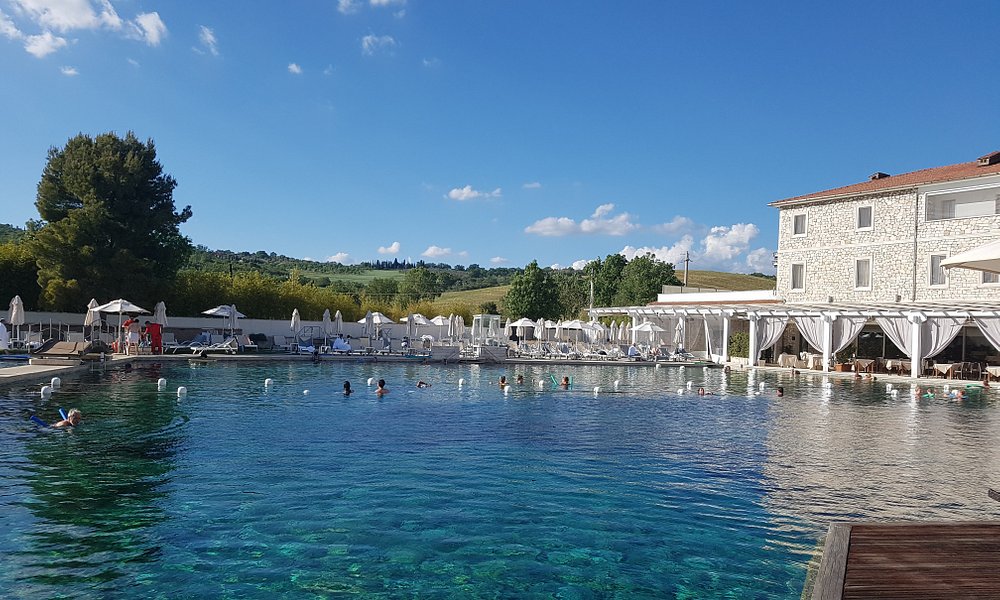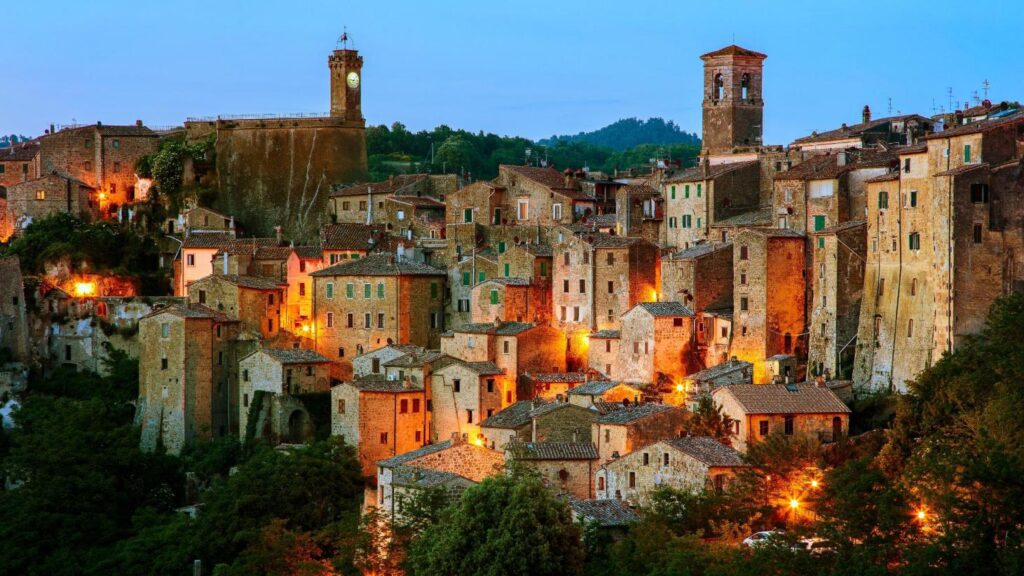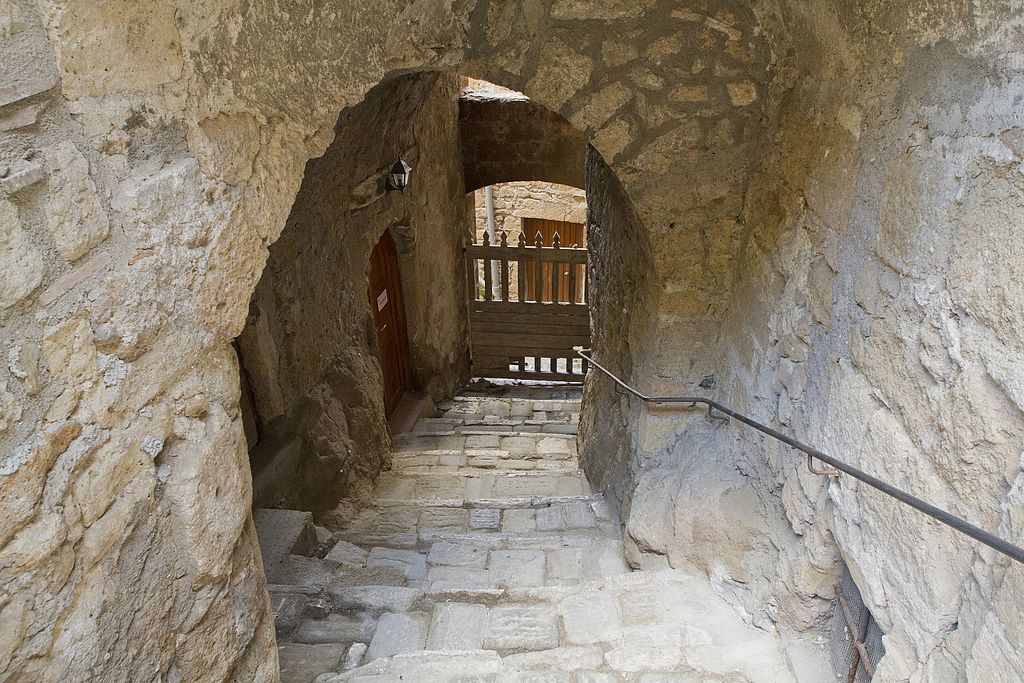At the heart of the city is Dante Alighieri square, a mock medieval space where you’ll find the Cathedral of San Lorenzo, remodelled in the 19th century in neo Romanesque-Gothic style.
Grosseto is a city and comune in the central Italian region of Tuscany, the capital of the Province of Grosseto. The city lies 14 kilometres (9 miles) from the Tyrrhenian Sea, in the Maremma, at the centre of an alluvial plain on the Ombrone river.
HIGLIGHTS
Grosseto is the out-of-the-way provincial capital of the Maremma, situated 14 km from the sea coast. It’s overlooked by the majority of tourists as there are no major sights here. But it’s a pleasant place with a nice central square and a well organised archeological museum filled with Etruscan artefacts.
The Cathedral of San Lorenzo might look Medieval but it’s not. The only surviving decorative elements that are original are the four symbols of the evangelists that stand on the cornice in front of the buttresses. Inside, some of the glass windows are the originals from 1400. Look out for the splendidly carved baptismal font and the painting “Madonna delle Grazie” (1470) by Matteo di Giovanni.
Church of San Francesco – the altar cross (1280-83) is attributed to the young Duccio di Buoninsegna. It shows impressive realism in the depiction of the body of Christ.
City walls – The 2900 meter long city walls have been turned into a tree lined walk way. There are six bastions (the fortress incorporates the medieval tower still visible today), and of the gates, the southern one is the eldest, dating from the 14th century. Until 1757 the walls were surrounded by a moat connected to a series of canals so that goods could be transported by boat.
Museo Archeologico e dell’Arte della Maremma – The museum spans the entire spectrum of Etruscan culture. There are exhibits of artefacts from the Villanova period (10th-8th c.) excavated in Vetulonia, and objects unearthed in Talamone, Sovana and Pitigliano, On the third floor there’s a museum of sacred art, mainly Medieval. The last rooms have a brief history of the city.
What’s nearby:
The area around Grosseto offers unspoiled beaches bordered by pine forests and peaceful countryside where agriturismi have flourished in the past few decades. The Uccellina Natural Park is just a few kilometers away.
Castiglione della Pescaia is one of the most attractive coastal towns in Tuscany.
Main sights
The Medicean Walls
The walls were commissioned by Cosimo I de Medici in 1564, in order to replace those from the 12th-14th centuries, as part of his policy of making Grosseto a stronghold to protect his southern border. The design was by Baldassarre Lanci, and construction began in 1565. Until 1757 the exterior was surrounded by a ditch with an earthen moat. There were two main gates: Porta Nuova on the north and Porta Reale (now Porta Vecchia) on the south.
Religious architecture
Cathedral
The Romanesque cathedral, the main monument of the city, is named for its patron St. Lawrence, and was begun at the end of the 13th century, by architect Sozzo Rustichini of Siena. Erected over the earlier church of Santa Maria Assunta, it was only finished in the 15th century (mainly due to the continuing struggles against Siena).
The façade of alternate layers of white and black marble is Romanesque in style, but is almost entirely the result of 16th century and 1816–1855 restorations: it retains decorative parts of the originary buildings, including Evangelists’ symbols. The layout consists of a Latin cross, with transept and apse. The interior has a nave with two aisles, separated by cruciform pilasters. The main artworks are a wondrously carved baptismal font from 1470–1474 and the Madonna delle Grazie by Matteo di Giovanni (1470).
The campanile (bell tower) was finished in 1402, and restored in 1911.
Churches in the city centre
- Church of San Francesco. Situated in its homonymous square, it was built in the 13th-century, initially an important Benedectine, later Franciscan convent. The complex underwent several restorations and reconstructions: the bell was rebuilt in the first half of the 20th century. Very characteristic is the wooden tabernacle that stands on the front and inside there are works of art from various historical periods. At the center of the cloister stands the characteristic Pozzo della Bufala (Well of the Buffalo) in travertine; another well is located in the square outside the church.
- Convent of Clarisse. Located on strada Vinzaglio, the convent is annexed to the Church of Bigi. The convent of Clarisse and the church of Bigi are now deconsacrated. The entire complex is characterized by the probable medieval origins, which was followed by a series of restorations in Baroque style in the 17th century. Today the convent hosts the Museolab Città di Grosseto and the university.
- Church of San Pietro. The oldest religious building in town, it was built along the stretch of the Via Aurelia that crossed the center and was originally a plebeian and stational church along the old consular road.
- Church of Misericordia (19th century). It belonged to various religious orders during the following centuries, before moving on brotherhood in the early decades of the 19th century. In the past, there were several well-preserved works of art currently on display in the section on Sacred Art of the Archaeological and Art Museum of Maremma.
Churches outside the city walls
- Sacro Cuore di Gesù, a minor basilica built in 1958, it was designed by engineer Ernesto Ganelli and it is located along via della Pace.
- Medaglia Miracolosa, built in the early 20th century behind the Palazzo delle Poste in a neo-Romanesque style. It has a bell tower.
- San Giuseppe, located in the western part of the urban area, it was built in the 1930s in neo-Romanesque style, divided into three naves. The capitals are adorned with very fine and decorative features.
- San Giuseppe Benedetto Cottolengo, built on the eastern end of the urban area around the middle of last century, the style is neo-Romanesque, it is flanked by a bell tower and preceded by steps and a porch. It was designed by engineer Ernesto Ganelli in 1951.
- Maria Santissima Addolorata, built in the 1970s in the neighbourhood of Gorarella, it was designed by architect Carlo Boccianti.
- Santissimo Crocifisso, a modern church situated in an area called Cittadella dello Studente, it was designed by Carlo Boccianti.
- Santa Lucia, a modern church situated in the neighbourhood of Barbanella.
- Santa Teresa, built in the 2000s (decade) and consecrated in 2006, it is situated in an area called Cittadella, on the northern part of the urban area.
Abbeys
- Abbey of San Rabano, at the southern end of the town of Grosseto in the heart of the Natural Park of Maremma. It was built in the Middle Ages as a Benedictine monastery, passed after the Order of the Knights of Jerusalem and it was finally abandoned in the 16th century.
- Abbey of San Pancrazio al Fango, situated between Grosseto and Castiglione della Pescaia, in the heart of Nature Reserve Diaccia Botrona, not far from the Fattoria della Badiola. The church, which is in the form of ruins, was built in the Middle Ages on a slight hill overlooking the surrounding wetlands, once occupied by Prile Lake near a building from Roman times.
Civil architecture
Palazzi
Within the walls of Grosseto are the following buildings:
- Palazzo Aldobrandeschi. Of medieval origins, it was almost entirely rebuilt in the early 19th century. It is now a Neo-Gothic edifice with ogival mullioned windows and merlons in the upper part of the walls. It houses the seat of the province of Grosseto. The architect was Lorenzo Porciatti.
- Palazzo Comunale (Town hall), located on the north side of piazza Dante, to the left of the churchyard of the Cathedral. It was built between 1870 and 1873.
- Episcopal Palace. It hosts the offices and the curia of the Roman Catholic Diocese of Grosseto.
- Palace of the former Convent (15th century), originally used as an unidentified convent structure.
- Palace of Monte dei Paschi, built at the turn of the 20th century, it is a neo-Renaissance palace designed by Vittorio Mariani, with a large arms of the bank placed on its main façade.
- Cassero del Sale, built during the 14th century as the point of production, distribution and export of salt coming from the salt marshes that once existed along the coast. For several centuries has hosted, therefore, the Customs Officer to control all activities related to production and trade of salt.
- Former Misericordia Hospital, a complex on three levels from the 18th century. Now the building hosts the university center of Grosseto.
- Former Palace of Banca d’Italia. Overlooking the southern side of piazza Socci, along Corso Carducci, it was renovated in the early 20th century to be the seat of the provincial Bank of Italy, then transferred out of the walls of Grosseto in a more modern and complex building.
- Grand Hotel Bastiani, located in an impressive neoclassical style palace that facing on via Manin, with a short road that leads toward piazza Dante.
- Palace of the Old Court, seat of the Museo archeologico e d’arte della Maremma since 1975, overlooking the south side of piazza Baccarini. The present building, formerly courthouse, was built in neo Renaissance in the second half of 19th century replacing an existing building of medieval origin.
- Palazzo del Genio Civile, typical building located along Corso Carducci, it is adjacent to Palazzo Tognetti, which is in continuity with the right side. Built in the early 20th century, it shows fine decorations that recall both the neo-Renaissance and the Art Nouveau style.
- Palazzo Chiarini, its present appearance dates back to the 17th century. The building has three levels, with round-arched entrance portal on the ground floor dominated by arms.
- Palazzo Tognetti, an Art Nouveau style building on three levels located at an angle along Corso Carducci just before piazza Socci.
- Palazzo Moschini, located in piazza Socci, it is a building of medieval origins, restored in the Renaissance and completely renovated during the 19th century. Currently, it houses the State Archives.
- Palazzo Carmignani, a landmark building built in the 20th century, it presents a trapezoidal shape, appearing between piazza del Sale, strada Ricasoli and via Mazzini.
- Palazzo Chiarini, located in via dell’Unione, its present appearance dates back to the 17th century. The building has three levels, with round-arched entrance portal on the ground floor dominated by arms.
- Palazzo Berti. Overlooking on Corso Carducci in the front of the Church of San Pietro, it is a stately and elegant building built on four levels. Built in the Middle Ages, its current appearance is due to restructurations in the second half of the 19th century.
- Palazzo Cappelli, located along Corso Carducci to the right of the Church of San Pietro, it is presented in an attractive neoclassical style.
- Palazzo Pallini, an art nouveau building of the early 20th century, it is located along Corso Carducci. Very valuable are the decorations that adorn the façade.
- Palazzo Mensini, built in 1898, it is the seat of the Biblioteca Chelliana.
- Casa del Fascio, also known as the Palazzo Littorio, it was built during Fascism in the traditional architectural principles with the characteristic tower. In the past, it hosted the Casa del Fascio (Fascist House), but now it is headquarters of the Guardia di Finanza.
Outside the walls of Grosseto are the following buildings:
- Villino Pastorelli, built between 1908 and 1913 by the architect Lorenzo Porciatti as the residence of the wealthy family of Millanta. The building was later owned by advocate Pastorelli, which retains the name. Purchased by the Banca Nazionale dell’Agricoltura after the war, suffered between 1948 and 1949 substantial changes, including the extension of the back.
- Villino Panichi, located in Piazza della Vasca on the corner of via IV Novembre, the building was built in early 20th century designed by the architect Lorenzo Porciatti, whose name was given by the family who lived there originally.
- Villino Guastini, built in 1928 by the architect Pistelli and located on via Matteotti, it is an Art Nouveau style house with a floor used as storage of agricultural machinery.
- Former Boarding School Magistrale, known as Scuola Media Giovanni Pascoli, located in Piazza della Vasca, it was built in 1923 by the engineer Giuseppe Luciani to accommodate boarding and a school.
- Palazzo delle Poste (Post Office), located on Piazza della Vasca, it was designed by the architect Angiolo Mazzoni in 1930, as a symbol of Fascist architecture.
- Palazzo del Governo, located on Piazza della Vasca, it was designed by Vittorio Mariani and built in 1927.
- Complesso polifunzionale Cosimini, located on Piazza della Vasca, it is a multipurpose facility (bank, offices, apartments and shops) designed by Ludovico Quaroni.
Theatres
- Teatro degli Industri, located along via Mazzini, just beyond the palace of the Grand Hotel Bastiani but on the side facing toward the walls of Grosseto, it is an old building rebuilt in the 19th century. It is one of the main sites of the culture of Grosseto.
- Teatro Moderno, a modern theatre located outside the city walls. It was used for the trial against Francesco Schettino in 2014/15.
Monuments
- Canapone Monument, a sculpture dedicated to the Grand Duke Leopold II of Lorraine, located in the center of Piazza Dante, at the spot where formerly stood a well-cistern for water.
- Roman column, located at the corner of the main façade and the right side of the Cathedral, it was brought in Piazza Dante in Middle Ages from nearby Roselle before its final abandonment.
- Unknown Soldier Monument, built in 1921, it is located along the walls, on the Rimembranza bastion. It honors the victims of World War I and World War II.
- Andrea da Grosseto Monument, made between 1973 and 1974 by sculptor Arnaldo Mazzanti, it is located in Piazza Baccarini, opposite the Archeological Museum, in honor of Andrea da Grosseto, the distinguished scholar who in 1268 translated the Moral Treatises of Albertanus of Brescia by providing a first example of Italian literary prose.
- Ettore Socci Monument, built in 1907 by Emilio Gallori in honor of Ettore Socci, a Republican, an honorary citizen and member of the College of Grosseto.
- Well of Spedale, made during the 15th century, it is located in Piazza San Francesco in front of the right lateral side of the Church of San Francesco.
- Well of Buffalo, located in the courtyard of the cloister of San Francesco, was built by the Medici to replace an existing well to supply water to the men who lived in the convent.
- Well of Fortezza, located in Piazza d’Armi inside the Fortezza bastion that surrounds the fortified Citadel, it was built in the 16th century for supply water of the guards stationed there.
Others
- The Etruscan site of Roselle.
- Medieval buildings in the frazioni of Batignano, Istia d’Ombrone and Montepescali.
- Granducal villa of Alberese, built by the Knights Hospitaller in the 15th century, and later used as residence by the Grand Dukes of Tuscany.
Culture
Museums
- Museo archeologico e d’arte della Maremma
- Museo di storia naturale della Maremma
- Museo Collezione Gianfranco Luzzetti
Cinema
Grosseto and Maremma have been settings for numerous works of fiction and movies, including the novels and associated films, such as The Easy Life (1962) with Vittorio Gassman; La vita agra (1964), from the novel of the same name by Luciano Bianciardi, with Ugo Tognazzi; An Ideal Place To Kill (1969) directed by Umberto Lenzi; In viaggio con papà (1982), with Alberto Sordi; Nothing Left to Do But Cry (1984), with Massimo Troisi and Roberto Benigni; It’s Happening Tomorrow (1988); Viola bacia tutti (1997) with Asia Argento; The Talented Mr. Ripley with Matt Damon and Jude Law; Emma sono io (2002); Roberto Benigni’s Pinocchio; Manuale d’amore 3 (2011) with Robert De Niro and Monica Bellucci; Swiss movie Summer Games, and some Leonardo Pieraccioni‘s movies. Famous Italian actress Elsa Martinelli and actor Luigi Pistilli were both born in Grosseto. Actress Laura Morante was born in Santa Fiora, and director Umberto Lenzi in Massa Marittima, both in the province of Grosseto.
Cuisine
Schiaccia alla pala (oven-baked bread with oil) and Schiaccia con cipolle e acciughe (oven-baked bread with onions and European anchovy) are typical breads of the city of Grosseto. Acquacotta is typical of Mount Amiata: it is a poor soup, and the main ingredients are artichokes, broccoli, cabbage, beans, borage, pisciacane (dandelion) and similar vegetables. The Maremmana cattle is one of the two breeds used in the preparation of the florentine steak.

